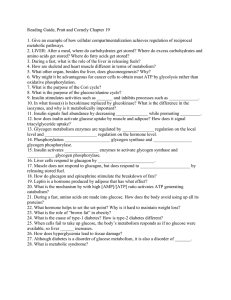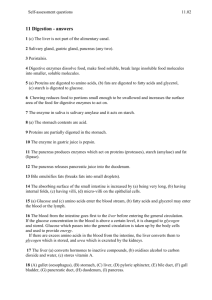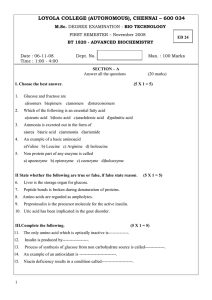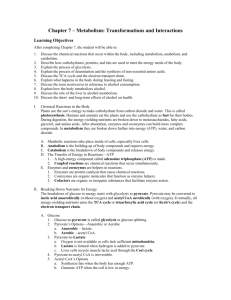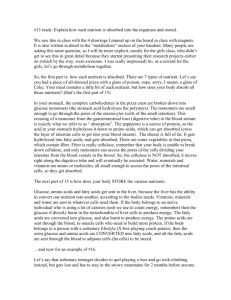Chapter 24 Metabolism and Energetics BIOL242
advertisement
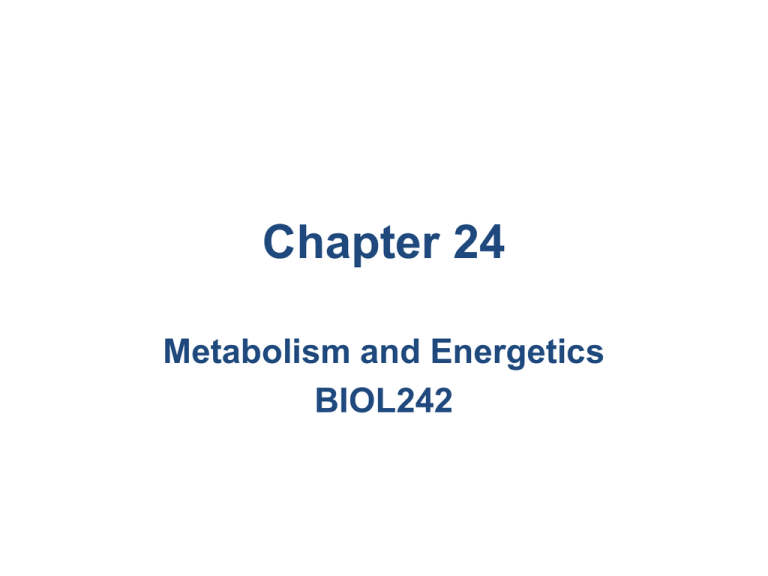
Chapter 24 Metabolism and Energetics BIOL242 Overview • • • • • • Overview of metabolism Carbohydrate metabolism Lipid metabolism Lipid Transport and utilization Metabolic tissues and interactions Diseases Fates of catabolized organic nutrients • Energy (ATP) • Raw materials later used in anabolism – Structural proteins – Enzymes – Lipid storage – Glycogen storage Glucose • Glucose is the molecule ultimately used by body cells to make ATP • Neurons and RBCs rely almost entirely upon glucose to supply their energy needs • Excess glucose is converted to glycogen or fat and stored Cellular Metabolism Figure 25–1 Nutrient Use in Cellular Metabolism Figure 25–2 (Navigator) Synthesis of New Organic Compounds • In energy terms, anabolism is an “uphill” process that forms new chemical bonds while catabolism is a downhill process that provides energy by breaking chemical bonds • Building new organic compounds requires both energy (garnered from earlier catabolism) and raw materials. Organic Compounds • Glycogen: – a branched chain of glucose molecules – most abundant storage carbohydrate • Triglycerides: – most abundant storage lipids – Energy is primarily stored in the fatty acids • Proteins: – most abundant organic components in body – perform many vital cellular functions Metabolism: the “5¢ Tour” • C-H bonds store the most energy • C-C also store a lot of energy • C-O bonds store very little energy Macromolecules that we take in via our diet are mostly rich in C-H and C-C bonds. In the body, these are broken down and turned into C-O bonds that are then breathed out as carbon dioxide. In the process, some of the energy released by breaking those bonds is captured to make ATP Carbohydrate Metabolism • Generates ATP and other high-energy compounds by breaking down carbohydrates: glucose + oxygen carbon dioxide + water • Occurs in small steps which release energy to convert ADP to ATP • Involves glycolysis, TCA cycle, and electron transport • 1 molecule of glucose nets 36* molecules of ATP Glycolysis • Breaks down glucose in cytosol into smaller molecules used by mitochondria • Does not require oxygen so it is anaerobic • 1 molecule of glucose yields only 2 ATP • Yields very little energy on its own, but it is enough to power your muscles for short periods • Some bacteria are entirely anaerobic and survive by performing only glycolysis • RBCs and working muscle tissue use glycolysis as their primary source of ATP Aerobic Reactions • Also called aerobic metabolism or cellular respiration • Include the TCA cycle and electron transport • Occur in mitochondria: – consume oxygen – produce lots of ATP – Much more efficient Overview – Aerobic metabolism • Glycolysis: – breaks 6-carbon glucose into two 3-carbon pyruvic acid (aka pyruvate) • TCA cycle – 3 carbon pyruvate is adapted into 2 carbon acetyl CoA (probably the most important, most central molecule in metabolism) – Acetyl CoA is conveted into carbon dioxide and the energy is captured in an intermediate called NADH • Electron Transport – Uses oxidative phosphorylation to turn NADH into ATP – requires oxygen and electrons; thus the rate of ATP generation is limited by oxygen or electrons Summary: ATP Production • For 1 glucose molecule processed, cell gains 36 molecules of ATP: – 2 from glycolysis – 4 from NADH generated in glycolysis (requires oxygen) – 2 from TCA cycle (through GTP) – 28 from electron transport Summary: Energy Yield of Aerobic Metabolism Figure 25–6 Carbohydrate Breakdown and Synthesis • Gluconeogenesis: synthesis (in liver) of glucose from noncarbohydrate precursors like – lactic acid – glycerol – amino acids • Glycogenolysis – breakdown of glycogen in response to low blood glucose • Both can provide glucose for the brain when fasting is prolonged Figure 25–7 Lipid Metabolism • Lipid molecules contain carbon, hydrogen, and oxygen in different proportions than carbohydrates • Triglycerides are the most abundant lipid in the body (mostly C-C, C-H bonds) Lipid Catabolism • Also called lipolysis • Breaks lipids down into pieces: – Glycerol gets converted to pyruvate enters glycolysis makes acetyl CoA – Fatty acids are converted to acetyl CoA that can be channeled directly into TCA cycle • Different enzymes convert fatty acids to acetyl-CoA in a process called betaoxidation Beta–Oxidation • A series of reactions that occurs inside mitochondria • Breaks fatty acid molecules into 2carbon fragments • Each step: – generates molecules of acetyl-CoA and NADH – leaves a shorter carbon chain bound to coenzyme A Figure 25–8 (Navigator) Free Fatty Acids • Are an important energy source during periods of starvation when glucose supplies are limited • Liver cells, cardiac muscle cells, skeletal muscle fibers, etc. metabolize free fatty acids • Excess dietary glycerol and fatty acids undergo lipogenesis to form triglycerides for storage • Glucose is easily converted into fat since acetyl CoA is: – An intermediate in glucose catabolism – The starting molecule for the synthesis of fatty acids Lipid Transport and Utilization Figure 25–9 Lipoproteins • Are lipid–protein complexes • Contain large insoluble glycerides and cholesterol • 5 Classes of Lipoproteins: – Chylomicrons = triglycerides from intestines to liver (and a few other sites) – VLDL = triglycerides from liver to tissues – IDL = triglycerides back to liver – LDL = cholesterol from liver to tissues – HDL = cholesterol from tissues to liver Chylomicrons • Are produced in intestinal tract • Are too large to diffuse across capillary wall • Enter lymphatic capillaries • Travel through thoracic duct to venous circulation and systemic arteries • Can be broken down by enzymes at the surface of cardiac, skeletal muscle, adipose, and liver cells Liver cells: Very Low Density Lipoproteins (VLDLs) • Distribution of other lipoproteins is controlled by liver through a series of steps • Liver cell enzyme lipoprotein lipase breaks down chylomicron lipids and stores them or pachages them for release: – When needed, liver synthesize VLDLs (mostly tryglcerides) for discharge into bloodstream VLDLs carry triglycerides to tissues • In peripheral capillaries, lipoprotein lipase removes many triglycerides from VLDL (and they are taken up by peripheral cells) leaving behind IDLs in the blood • Triglycerides that reach the tissues are broken down into fatty acids and monoglycerides Intermediate Density Lipoproteins (IDLs) return to liver • When IDLs reach liver: – additional triglycerides are removed – protein content of lipoprotein is altered, creating LDLs • LDLs (mostly cholesterol) deliver cholesterol to peripheral tissues Low Density Lipoproteins (LDLs) enter peripheral cells • LDLs leave bloodstream through capillary pores or cross endothelium by vesicular transport • LDLs are absorbed through receptor-mediated endocytosis • Amino acids and cholesterol enter the cytoplasm • Cholesterol not used by the cell diffuses out of cell • This is the “ bad ” cholesterol because a congenital lack of LDL receptors or a diet high in saturated fat and/or cholesterol causes LDL to stay in bloodstream where it can contribute to atherosclerotic plaques High Density Lipoproteins (HDLs) shuttle between liver and periphery • Cholesterol that is not used reenters bloodstream and is absorbed by HDLs (produced by the liver with the express purpose of picking up cholesterol in the tissues) and returned to liver for storage or excretion (in bile), or to make LDLs to deliver to the tissues • This is “good” cholesterol because it does not stay in the blood long and actually mops up free cholesterol molecules Summary of Lipoproetins • Chylomicrons = triglycerides from intestines to liver (and a few other sites) • VLDL = triglycerides from liver to tissues • IDL = triglycerides back to liver • LDL = cholesterol from liver to tissues • HDL = cholesterol from tissues to liver Proteins: Synthesis and Hydrolysis • All-or-none rule – All amino acids needed must be present at the same time for protein synthesis to occur • Adequacy of caloric intake – Protein will be used as fuel if there is insufficient carbohydrate or fat available Protein Synthesis • The body synthesizes half of the amino acids needed to build proteins • Nonessential amino acids: – amino acids made by the body on demand • 10 essential amino acids not made in the body in sufficient quantities • All must be eaten at the same time (beans and rice) Protein Metabolism • Excess dietary protein results in amino acids being: – Oxidized for energy – Converted into fat for storage • Amino acids must be deaminated prior to oxidation for energy • Nitrogen balance must be maintained Summary: Pathways of Catabolism and Anabolism Take home message: Anything can become acetylCoA, but acetylCoA can only be used for energy or stored as FAT 5 Metabolic Tissues • 1. 2. 3. 4. 5. Nutrient requirements of each tissue vary with types and quantities of enzymes present in cell Liver Adipose tissue Skeletal muscle Neural tissue Other peripheral tissues The Liver • The focal point of metabolic regulation and control • Contains great diversity of enzymes that break down or synthesize carbohydrates, lipids, and amino acids • Liver Cells – Have an extensive blood supply – Monitor and adjust nutrient composition of circulating blood – Contain significant energy and vitamin reserves (glycogen deposits) Adipose Tissue • Stores lipids, primarily as triglycerides • Adipocytes located in: – areolar tissue – mesenteries – red and yellow marrows – epicardium – around eyes and kidneys – adipose tissues Skeletal Muscle • Maintains substantial glycogen reserves • Contractile proteins can be broken down and the amino acids used as energy source Neural Tissue • Doesn’t maintain reserves of carbohydrates, lipids, or proteins • Requires reliable supply of glucose: – cannot metabolize other molecules • The CNS cannot function in low-glucose conditions, individual becomes unconscious Other Peripheral Tissues • Do not maintain large metabolic reserves • Can metabolize glucose, fatty acids, and other substrates • Preferred energy source varies according to instructions from endocrine system Metabolic Interactions • • Relationships among 5 components change over 24-hour period Body has 2 patterns of daily metabolic activity: 1. absorptive state is the period following a meal when nutrient absorption is under way 2. postabsorptive state is the period when nutrient absorption is not under way and the body relies on internal energy reserves Absorptive State • In the absorptive state after a meal: – Insulin dominates – cells absorb nutrients to support growth and maintenance – nutrients are stored as energy reserves Postabsorptive state • In the postabsorptive state seveal hours after a meal: – Glucagon, epinephrine, and glucocorticoids dominate – Liver and muscle cells initially break down glycogen but soon they switch to using fatty acids and amino acids which generate acetyl-CoA with lead to the formation of ketone bodies – gluconeogenesis in the liver maintains blood glucose levels (for what organ?) – cells conserve energy by shifting to lipid based metabolism Ketone Bodies • Are acids that dissociate in solution • Liver cells do not catabolize ketone bodies: – compounds diffuse into general circulation – peripheral cells absorb ketone bodies • Cells reconvert ketone bodies to acetyl-CoA for TCA cycle • If necessary, ketone bodies become preferred energy source • Metabolic shift reserves circulating glucose for use by neurons Ketone Bodies • Ketonemia is the appearance of ketone bodies in bloodstream – Lowers plasma pH, which must be controlled by buffers • Fasting produces ketosis: – a high concentration of ketone bodies in body fluids • Ketoacidosis Is a dangerous drop in blood pH: – caused by high ketone levels that exceed buffering capacities – Brain uses ketone bodies as a last resort, can become unconscious The Energy Content of Food • • • • Lipids release 9.46 C/g Carbohydrates release 4.18 C/g Proteins release 4.32 C/g Why is this? Think about what I said about C-H bonds, etc. Metabolic Rate • Is the sum of all anabolic and catabolic processes in the body • Changes according to activity • Basal Metabolic Rate (BMR) is the minimum resting energy expenditure of an awake and alert person measured under standardized testing conditions – Involves monitoring respiratory activity because energy utilization is proportional to oxygen consumption Metabolic Rate • If daily energy intake exceeds energy demands: – body stores excess energy as triglycerides in adipose tissue • If daily caloric expenditures exceeds dietary supply: – body uses energy reserves, loses weight Hormonal Effects • Thyroxine: – controls overall metabolism – T4 assay measures thyroxine in blood • Cholecystokinin (CCK): – suppresses appetite • Adrenocorticotropic hormone (ACTH): – suppresses appetite • Leptin: – released by adipose tissues during absorptive state – binds to CNS neurons that suppress appetite Summary • • • • • • Overview of metabolism Carbohydrate metabolism Lipid metabolism Lipid Transport and utilization Metabolic tissues and interactions Diseases: next Diseases Esophageal, Stomach and Intestinal Problems • Espohageal varicies: high pressure in hepatic portal vein causes blood to pool in submucosa of esophagus, rupture causes bleeding • Peptic ulcers: acids and enzymes wear a hole into the digestive epithelial lining into the lamina propria. Associated with a bacterium (h. pylori). • Vomiting: stomach regurgitates contents up through esophagus and out (contents of jejunum and duodenum are moved into stomach in preparation). Reflex oordinated in medulla Liver disease • Cirrhosis: destruction of hepatocytes and scarring of the liver often due to alcohol. Fibrosis causes enlargement and toughening of liver, jaundice may result (buildup of bilirubin in the blood, tissues) • Hepatitis: Viral infection of liver – A (infectious): contaminated food, usually short lived – B (serum): bodily fluids, can be chronic – C: contact with contaminated blood, chronic, causes sever liver problems, cirrhosis, esophageal varicies, liver cancer. Early treatment with interferon can lead to remission. Gallstones • Cholecystitis – inflammation of gallbladder due to blocked bile duct • Pancreatitis – most frequently caused by a blockage of the pancreatic duct at the site where it meets the common bile duct causes buildup, activation of digestive enzymes pancreas digests itself! Colon Problems • Colon cancer: very common, high mortality • IBD (Crohn’s & Colitis): severe persistent inflammation, may require resection • Cholera: fecal-borne pathogen that binds to intestinal lining, causes loss of fluids, death due to acute dehydration • Constipation: when fecal material stays in the colon too long, too much water is reabsorbed, hard to pass. Common in the elderly due to decreased smooth muscle tone that occurs with aging • Lactose intolerance: lack of lactase (where?) leads to lactose digestion by colonic bacteria, gas, diarrhea Metabolic issues • PKU (phenylketonuria): lack of enzyme phenylalanine hydroxylase that converts amino acid phenylalanine into tyrosine. Causes developing neurons to die if not diagnosed early. Treatment = limit penylalanine intake but tyrosine becomes as essential amino acid • Starvation protein deficiency (Kwashiorkor): lack of plasma proteins (which are broken down for energy) causes a decrease in BCOP, increased filtration causes peritoneal edema = ascites
